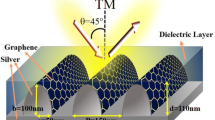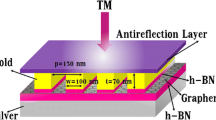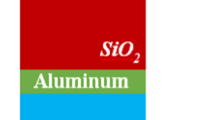Abstract
Graphene is today one of the most used materials in the production of optical devices such as photovoltaic cells, sensors and absorbers. Graphene’s unique ability to generate superb surface plasmons creates unique potential for using in absorbent materials. Graphene-based absorbers are very efficient for the application of absorber sensors, solar absorbers and terahertz absorbers. Absorber sensors by using the tunable properties of graphene are applicable in biosensors for the detection of hemoglobin, urine biomolecules and are also applicable in medical and chemical applications. Solar absorbers are suitable for use in energy harvesting devices and clean energy production. The use of graphene layer in the design of the solar absorber gives a very efficient absorption response and a suitable bandwidth. THz absorbers are applicable in sensing and imaging devices. In this research, we investigated the optical properties of graphene in a grating structure as an optical absorber and optimized the dimensions of the structure to achieve greater absorption of a single-layer graphene. We place gold nanoribbons on top of the single-layer graphene and place an anti-reflection layer on top of the structure to prevent reflection and increase light absorption by the structure. At first, this structure is examined under the TM plane wave radiation with 0° incident angle. In the next step, we optimized the dimensions of the grating by changing the width of the nanoribbons and the period of repetition of the structure. The processed structure increased the single layer graphene absorption by 60% and total absorption up to 80%. The total absorption of the optimal structure at a wavelength of about 590 nm, 100% absorption of the structure was observed. Next, we examined the behavior of graphene absorption peaks in the near-infrared area by changing the angle of incident light with the values of 15, 30, 45, 60, 75, and 90°. By analyzing graphene behavior in this area, we saw that by changing the dimensions of gold nanoribbons, the wavelength of absorption peak can be controlled from 1000 to 1600 nm. In the next step, we found that the absorption peak of structure is not sensitive to the angle of incident light, and there is no significant difference in the maximum absorption of graphene layer by changing the angle of the incident light. With high efficiency and low-angle sensitivity, this absorber has a great ability to absorb solar radiation and has rich applications in solar cells, infrared and thermal trackers.







Similar content being viewed by others
Data Availability
The research data associated with a paper is available, and under what conditions the data can be accessed.
References
Ghobadi A et al (2018) Tuning the metal filling fraction in metal-insulator-metal ultra-broadband perfect absorbers to maximize the absorption bandwidth. Photonics Res 6(3):168–176
Zhang Y et al (2015) Independently tunable dual-band perfect absorber based on graphene at mid-infrared frequencies. Sci Rep 5(1):18463
**a S-X et al (2017) Multi-band perfect plasmonic absorptions using rectangular graphene gratings. Opt Lett 42(15):3052–3055
Yong Z et al (2016) Narrow band perfect absorber for maximum localized magnetic and electric field enhancement and sensing applications. Sci Rep 6(1):24063
Lei L et al (2018) Ultra-broadband absorber from visible to near-infrared using plasmonic metamaterial. Opt Express 26(5):5686–5693
Zhou J et al (2018) Perfect ultraviolet absorption in graphene using the magnetic resonance of an all-dielectric nanostructure. Opt Express 26(14):18155–18163
Yildirim DU, Ghobadi A, Ozbay E (2018) Near-absolute polarization insensitivity in graphene based ultra-narrowband perfect visible light absorber. Sci Rep 8(1):15210
Chen Y et al (2015) Tunable near-infrared plasmonic perfect absorber based on phase-change materials. Photonics Res 3(3):54–57
Toudert J et al (2018) Mid-to-far infrared tunable perfect absorption by a sub-λ/100 nanofilm in a fractal phasor resonant cavity. Opt Express 26(26):34043–34059
Liu H et al (2019) Vanadium dioxide-assisted broadband tunable terahertz metamaterial absorber. Sci Rep 9(1):5751
Jablan M, Buljan H, Soljačić M (2009) Plasmonics in graphene at infrared frequencies. Phys Rev B 80(24):245435
Rodrigo D et al (2015) Mid-infrared plasmonic biosensing with graphene. Science 349(6244):165–168
Moskovits M (1985) Surface-enhanced spectroscopy Reviews of modern physics 57(3):783
Hillenbrand R, Taubner T, Keilmann F (2002) Phonon-enhanced light–matter interaction at the nanometre scale. Nature 418(6894):159–162
Dintinger J et al (2005) Strong coupling between surface plasmon-polaritons and organic molecules in subwavelength hole arrays. Phys Rev B 71(3):035424
Gao J, Liu J, Yang H, Liu H, Zeng G, Huang B et al (2023) Anisotropic medium sensing controlled by bound states in the continuum in polarization-independent metasurfaces. Optics Express 31(26):44703–44719. https://doi.org/10.1364/OE.509673
Liu Z et al (2017) Ultra-broadband tunable resonant light trap** in a two-dimensional randomly microstructured plasmonic-photonic absorber. Sci Rep 7(1):43803
Omelyanovich M, Ra’di Y, Simovski C (2015) Perfect plasmonic absorbers for photovoltaic applications. J Opt 17(12)
West PR et al (2010) Searching for better plasmonic materials. Laser Photonics Rev 4(6):795–808
Wang F et al (2008) Gate-variable optical transitions in graphene. Sci 320(5873):206–209
Low T, Avouris P (2014) Graphene plasmonics for terahertz to mid-infrared applications. ACS Nano 8(2):1086–1101
Chen J, Zhang Z, Lu H (2022) Structure design and properties investigation of Bi2O2Se/graphene van der Waals heterojunction from first-principles study. Surf Interfaces 33:102289. https://doi.org/10.1016/j.surfin.2022.102289
Ooi KJ et al (2016) Ultrafast, broadband, and configurable midinfrared all-optical switching in nonlinear graphene plasmonic waveguides. APL Photonics 1(4)
Li W et al (2014) Ultrafast all-optical graphene modulator. Nano Lett 14(2):955–959
Chang H, Wu H (2013) Graphene-based nanomaterials: synthesis, properties, and optical and optoelectronic applications. Adv Func Mater 23(16):1984–1997
Bonaccorso F et al (2010) Graphene photonics and optoelectronics. Nat Photonics 4(9):611–622
Guo CC et al (2016) Experimental demonstration of total absorption over 99% in the near infrared for monolayer-graphene-based subwavelength structures. Adv Opt Mater 4(12):1955–1960
Wood RW (1902) XLII. On a remarkable case of uneven distribution of light in a diffraction grating spectrum. Lond Edinb Dublin Philos Mag J Sci 4(21):396–402
Li H, Niu J, Wang G (2019) Dual-band, polarization-insensitive metamaterial perfect absorber based on monolayer graphene in the mid-infrared range. Res Phys 13
Liang C et al (2019) A broadband and polarization-independent metamaterial perfect absorber with monolayer Cr and Ti elliptical disks array. Res Phys 15
Liu Y, Liu Y, Wang M (2017) Design, optimization and application of small molecule biosensor in metabolic engineering. Front Microbiol 8:2012
Jiang C, Deng Z, Liu B, Li J, Han Z, Ma, Y.,... Ma Y (2022) Spin–orbit-engineered selective transport of photons in plasmonic nanocircuits with panda-patterned transporters. ACS Photonics 9(9):3089–3093. https://doi.org/10.1021/acsphotonics.2c00841
Parmar J, Patel SK (2022) Encrypted and tunable graphene-based metasurface refractive index sensor. Microw Opt Technol Lett 64(1):77–82
Zhang X, Tang Y, Zhang F, Lee C (2016) A novel aluminum-graphite dual-ion battery. Adv Energy Mater 6(11):1502588. https://doi.org/10.1002/aenm.201502588
Patel SK et al (2021) Graphene-based plasmonic absorber for biosensing applications using gold split ring resonator metasurfaces. J Lightwave Technol 39(17):5617–5624
Yu S, Yi W (2007) Single-walled carbon nanotubes as a chemical sensor for SO2 detection. IEEE Trans Nanotechnol 6(5):545–548
Lan G, Tang L, Dong J, Nong J, Luo P, Li X,... Wei W (2023) Enhanced Asymmetric Light-Plasmon Coupling in Graphene Nanoribbons for High-Efficiency Transmissive Infrared Modulation. Laser Photonics Rev. https://doi.org/10.1002/lpor.202300469
Shi X et al (2017) A novel method for the rapid detection of microbes in blood using pleurocidin antimicrobial peptide functionalized piezoelectric sensor. J Microbiol Methods 133:69–75
Grigorenko AN, Polini M, Novoselov K (2012) Graphene plasmonics. Nat Photonics 6(11):749–758
Atwater HA, Polman A (2010) Plasmonics for improved photovoltaic devices. Nat Mater 9(3):205–213
Qiu Y, Shi M, Guo X, Li J, Wu J, Zhou Y,... Li Y (2023) Sensitivity improvement in the measurement of minor components by spatial confinement in fiber-optic laser-induced breakdown spectroscopy. Spectrochimica Acta Part B: Atomic Spectroscopy 209:106800. https://doi.org/10.1016/j.sab.2023.106800
Darmo J et al (2004) Imaging with a Terahertz quantum cascade laser. Opt Express 12(9):1879–1884
Federici JF et al (2005) THz imaging and sensing for security applications—explosives, weapons and drugs. Semicond Sci Technol 20(7):S266
Jiang W, Wang H, **e W, Qu Z (2023) Lithography alignment techniques based on Moiré Fringe. Photonics 10(4):351. https://doi.org/10.3390/photonics10040351
Tittl A et al (2015) A switchable mid-infrared plasmonic perfect absorber with multispectral thermal imaging capability. Adv Mater 27(31):4597–4603
Lu Y, Stegmaier M, Nukala P, Giambra MA, Ferrari S, Busacca A,... Agarwal R (2017) Mixed-mode operation of hybrid phase-change nanophotonic circuits. Nano Letters 17(1):150–155. https://doi.org/10.1021/acs.nanolett.6b03688
Koppens FH, Chang DE, García de Abajo FJ (2011) Graphene plasmonics: a platform for strong light–matter interactions. Nano lett 11(8):3370–3377
Thongrattanasiri S, Koppens FH, De Abajo FJG (2012) Complete optical absorption in periodically patterned graphene. Phys Rev Lett 108(4):047401
Bruna M, Borini S (2009) Optical constants of graphene layers in the visible range. Appl Phys Lett 94(3)
Zhao C, Cheung CF, Xu P (2020) High-efficiency sub-microscale uncertainty measurement method using pattern recognition. ISA Transactions 101:503–514. https://doi.org/10.1016/j.isatra.2020.01.038
Cai Y, Zhu J, Liu QH (2015) Tunable enhanced optical absorption of graphene using plasmonic perfect absorbers. Appl Phys Lett 106(4)
Dean CR et al (2010) Boron nitride substrates for high-quality graphene electronics. Nat Nanotechnol 5(10):722–726
Zeitler M, Sienz S, Rauschenbach B (1999) Study of stress evolution of boron nitride films prepared by ion assisted deposition. J Vac Sci Technol A Vac Surf Films 17(2):597–602
Fan Y et al (2018) Monolayer-graphene-based broadband and wide-angle perfect absorption structures in the near infrared. Sci Rep 8(1):13709
Woessner A et al (2015) Highly confined low-loss plasmons in graphene–boron nitride heterostructures. Nat Mater 14(4):421–425
Du S, **e H, Yin J, Fang T, Zhang S, Sun Y,... Zheng R (2023) Competition pathways of energy relaxation of hot electrons through coupling with optical, surface, and acoustic phonons. J Phys Chem C 127(4):1929–1936. https://doi.org/10.1021/acs.jpcc.2c07791
Li Z, Zhang W, **ng F (2019) Graphene optical biosensors. Int J Mol Sci 20(10):2461
Parmar J et al (2019) Graphene-silicon hybrid chirped-superstructure bragg gratings for far infrared frequency. Mat Res Express 6(6)
Patel SK et al (2020) Graphene-based highly sensitive refractive index biosensors using C-shaped metasurface. IEEE Sens J 20(12):6359–6366
Al-Ashi NE et al (2020) Optical fiber surrounded by a graphene layer as an optical sensor. Opt Quant Electron 52(3):187
Patel SK et al (2020) Design of graphene metasurface based sensitive infrared biosensor. Sens Actuators A 301:111767
Shushama KN et al (2017) Graphene coated fiber optic surface plasmon resonance biosensor for the DNA hybridization detection: simulation analysis. Opt Commun 383:186–190
Acknowledgements
The author would like to thank the reviewers for their significant comments.
Author information
Authors and Affiliations
Contributions
Afroozeh wrote the main manuscript text and prepared figures.
Corresponding author
Ethics declarations
Consent to Participate
The author participates in drafting the article or revising it critically for important intellectual content.
Consent for Publication
The author of this paper agrees to publish our theoretical research.
Conflict of Interest
Author declares no conflicts of interest.
Additional information
Publisher's Note
Springer Nature remains neutral with regard to jurisdictional claims in published maps and institutional affiliations.
Rights and permissions
Springer Nature or its licensor (e.g. a society or other partner) holds exclusive rights to this article under a publishing agreement with the author(s) or other rightsholder(s); author self-archiving of the accepted manuscript version of this article is solely governed by the terms of such publishing agreement and applicable law.
About this article
Cite this article
Afroozeh, A. Investigating the Optical Properties of Graphene in a Grating Structure as an Optical Absorber and Optimized the Dimensions of a Single-Layer Graphene. Plasmonics (2023). https://doi.org/10.1007/s11468-023-02164-6
Received:
Accepted:
Published:
DOI: https://doi.org/10.1007/s11468-023-02164-6




